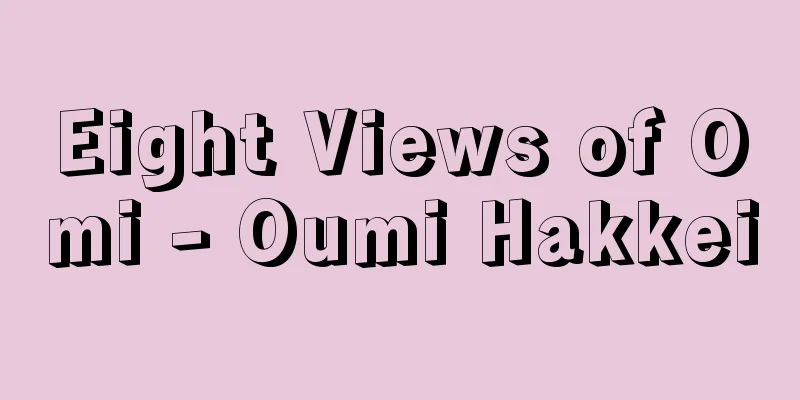Eight Views of Omi - Oumi Hakkei

|
This indicates scenic spots along the shores of Lake Biwa in Shiga Prefecture. Some say that they were selected by court nobles and poets from the Five Mountains during the Warring States period, while others say that they were selected in 1500 (Meiō 9) by the former chancellor Konoe Masaie and his son Hisamichi. Either way, it is said that they were chosen to imitate the Eight Views of Xiaoxiang of Lake Dongting in China. The commonly known Eight Views of Omi are "Evening Snow at Hira," "Rakugan at Katata," "Night Rain at Karasaki," "Evening Bell at Mii," "Returning Sails at Yabase," "Clear Storm at Awazu," "Autumn Moon at Ishiyama," and "Evening Light at Seta," and they were selected in the early Edo period. They were widely publicized through the ukiyo-e prints of Utagawa Hiroshige and the koto music of Yamato Manwa. However, because these eight views were limited to the southern part of the lake, and because the landscape had changed so dramatically that most of the former scenery had been lost, the "Eight Views of Lake Biwa" were newly established in 1949 (Showa 24). These are: Setting Sun (Clear Streams of Setaishiyama), Smoky Rain (Forests of Hiei), Cool Breeze (White Shores of Omatsuzaki), Dawn Mist (Rocks of Kaizu Osaki), Fresh Snow (Great View of Shizugatake), Moonlight (Ancient Castle of Hikone), Spring Colors (Water Town of Azuchi Hachiman), and Deep Green (Sunset on Chikubushima Island). [Seiichi Takahashi] Version by Eikichi Uoya (Uoei) ( Owned by the National Diet Library ) Hiroshige Utagawa's "Eight Views of Omi: Evening Snow at Hira" Version by Eikichi Uoya (Uoei) ( Owned by the National Diet Library ) Hiroshige Utagawa "Eight Views of Omi: Katada Rakugan" Version by Eikichi Uoya (Uoei) ( Owned by the National Diet Library ) Hiroshige Utagawa "Eight Views of Omi: Night Rain at Karasaki" Version by Eikichi Uoya (Uoei) ( Owned by the National Diet Library ) Hiroshige Utagawa's "Eight Views of Omi: The Evening Bell at Mitsui" Version by Eikichi Uoya (Uoei) ( Owned by the National Diet Library ) Hiroshige Utagawa "Eight Views of Omi: Return to Yabashi" Version by Eikichi Uoya (Uoei) ( Owned by the National Diet Library ) Hiroshige Utagawa "Eight Views of Omi: Awazu Clear Storm" Version by Eikichi Uoya (Uoei) ( Owned by the National Diet Library ) Hiroshige Utagawa "Eight Views of Omi: Autumn Moon at Ishiyama" Version by Eikichi Uoya (Uoei) ( Owned by the National Diet Library ) Hiroshige Utagawa "Eight Views of Omi: Evening Light at Seta" 1854 (Ansei 1) Edition by Moriya Jihei (Moriji) National Diet Library Utagawa Fusatane, "Eight Views of Omi: Evening Snow at Hira" 1854 (Ansei 2) Edition by Moriya Jihei (Moriji) National Diet Library Utagawa Fusatane, "Eight Views of Omi: Katada Rakugan" 1854 (Ansei 1) Edition by Moriya Jihei (Moriji) National Diet Library Utagawa Fusatane, "Eight Views of Omi: Night Rain at Karasaki" 1854 (Ansei 1) Edition by Moriya Jihei (Moriji) National Diet Library Utagawa Fusatane "Eight Views of Omi: The Evening Bell of Mitsui" 1854 (Ansei 1) Edition by Moriya Jihei (Moriji) National Diet Library Utagawa Fusatane, "Eight Views of Omi: Return of the Yabashi Bridge" 1854 (Ansei 1) Edition by Moriya Jihei (Moriji) National Diet Library Utagawa Fusatane, "Eight Views of Omi: Awazu Clear Storm" 1854 (Ansei 1) Edition by Moriya Jihei (Moriji) National Diet Library Utagawa Fusatane, "Eight Views of Omi: Autumn Moon at Ishiyama" 1854 (Ansei 1) Edition by Moriya Jihei (Moriji) National Diet Library Utagawa Fusatane, "Eight Views of Omi: Evening Light at Seta" Source: Shogakukan Encyclopedia Nipponica About Encyclopedia Nipponica Information | Legend |
|
滋賀県の琵琶湖(びわこ)沿岸の景勝地を示すもの。戦国時代に公家(くげ)や五山の詩僧によって選定されたとも、また1500年(明応9)前関白近衛(このえ)政家と尚通(ひさみち)の父子が選定したともいう。いずれにしても中国の洞庭湖の「瀟湘八景(しょうしょうはっけい)」を模して選んだといわれる。一般的に知られている近江八景は、比良(ひら)の暮雪(ぼせつ)、堅田(かたた)の落雁(らくがん)、唐崎(からさき)の夜雨(やう)、三井(みい)の晩鐘(ばんしょう)、矢橋(やばせ)の帰帆(きはん)、粟津(あわづ)の晴嵐(せいらん)、石山(いしやま)の秋月、瀬田の夕照(せきしょう)で、これは江戸時代初期に選定されたものらしい。歌川広重(ひろしげ)の浮世絵や山登万和(やまとまんわ)の箏曲(そうきょく)によって広く世間に喧伝(けんでん)された。 しかしこの八景は湖南に限られていること、激しい景観の変容でかつてのおもかげがほとんど失われたことなどから、1949年(昭和24)に「琵琶湖八景」が新たに制定された。夕陽(瀬田石山の清流)、煙雨(えんう)(比叡(ひえい)の樹林)、涼風(雄松崎(おまつざき)の白汀(はくてい))、暁霧(ぎょうむ)(海津大崎の岩礁)、新雪(賤ヶ岳(しずがたけ)の大観)、月明(彦根(ひこね)の古城)、春色(安土八幡(あづちはちまん)の水郷)、深緑(竹生島(ちくぶしま)の沈影)である。 [高橋誠一] 魚屋栄吉(魚栄)版国立国会図書館所蔵"> 歌川広重『近江八景 比良暮雪』 魚屋栄吉(魚栄)版国立国会図書館所蔵"> 歌川広重『近江八景 堅田落雁』 魚屋栄吉(魚栄)版国立国会図書館所蔵"> 歌川広重『近江八景 唐崎夜雨』 魚屋栄吉(魚栄)版国立国会図書館所蔵"> 歌川広重『近江八景 三井晩鐘』 魚屋栄吉(魚栄)版国立国会図書館所蔵"> 歌川広重『近江八景 矢橋帰帆』 魚屋栄吉(魚栄)版国立国会図書館所蔵"> 歌川広重『近江八景 粟津晴嵐』 魚屋栄吉(魚栄)版国立国会図書館所蔵"> 歌川広重『近江八景 石山秋月』 魚屋栄吉(魚栄)版国立国会図書館所蔵"> 歌川広重『近江八景 瀬田夕照』 1854年(安政1) 森屋治兵衛(森治)版国立国会図書館所蔵"> 歌川房種『近江八景 比良暮雪』 1854年(安政2) 森屋治兵衛(森治)版国立国会図書館所蔵"> 歌川房種『近江八景 堅田落雁』 1854年(安政1) 森屋治兵衛(森治)版国立国会図書館所蔵"> 歌川房種『近江八景 唐崎夜雨』 1854年(安政1) 森屋治兵衛(森治)版国立国会図書館所蔵"> 歌川房種『近江八景 三井晩鐘』 1854年(安政1) 森屋治兵衛(森治)版国立国会図書館所蔵"> 歌川房種『近江八景 矢橋帰帆』 1854年(安政1) 森屋治兵衛(森治)版国立国会図書館所蔵"> 歌川房種『近江八景 粟津晴嵐』 1854年(安政1) 森屋治兵衛(森治)版国立国会図書館所蔵"> 歌川房種『近江八景 石山秋月』 1854年(安政1) 森屋治兵衛(森治)版国立国会図書館所蔵"> 歌川房種『近江八景 瀬田夕照』 出典 小学館 日本大百科全書(ニッポニカ)日本大百科全書(ニッポニカ)について 情報 | 凡例 |
>>: Omihachiman [city] - Omihachiman
Recommend
Onbashira pulling rope
…There are many examples of using strings in conn...
Speed governer
A control device for keeping the engine speed con...
European Council
…the collective name for the three supranational ...
Boric acid (English spelling)
A general term for oxoacids of boron, including or...
Error control
...The contents of the sender's buffer are pr...
linearly polarized light
… [Type of polarization] Polarized light can be d...
Aoshima (Ehime) - Aoshima
…Lumber from the Hijikawa River basin was unloade...
Marko
...The legend of Prince Marko, the hero of a seri...
Kiso Fukushima [town] - Kiso Fukushima
A former town in Kiso County, southwestern Nagano ...
Kirkwall
Orkney is the administrative capital of the Orkney...
Golden Module - Ogon no Moduru
…The three dimensions of a man's hand raised,...
Cho (goldfish fly) - Cho (English spelling) fish lice
A small crustacean of the subclass Branchioura and...
Space Egg - Uchuran
…In other words, the larger the eggs that are lai...
Azuki bean weevil - Azuki bean weevil
...An insect of the beetle order Bruchidae family...
Real Estate Execution
Compulsory execution is carried out against real e...









